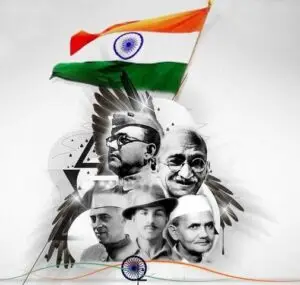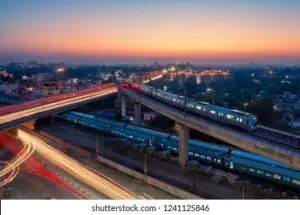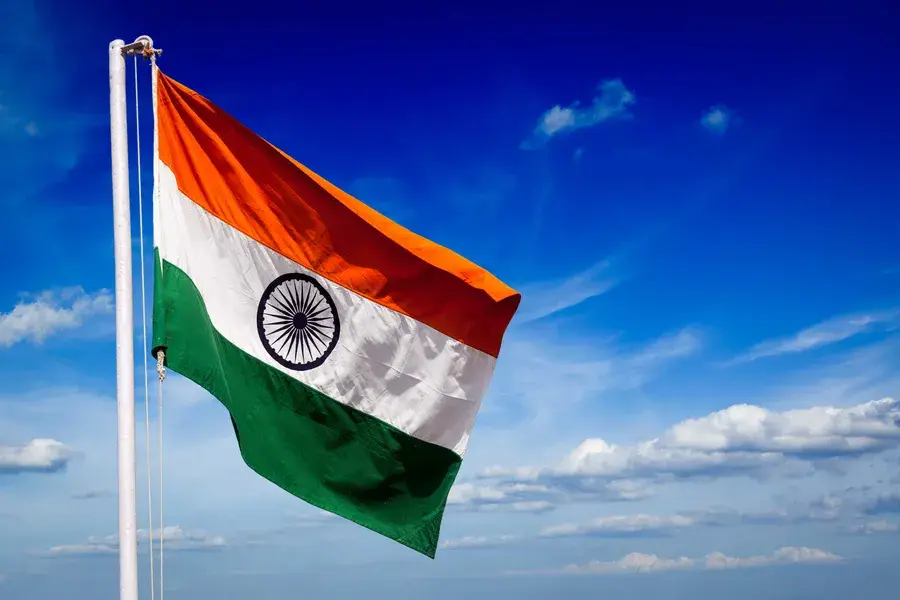Introduction

Independence Day in India, celebrated on August 15th each year, is a day of immense pride and reflection. It marks the end of British colonial rule in 1947 and the birth of a free and sovereign nation. As we look back on this significant day, it is essential to not only celebrate our freedom but also to recognize the remarkable journey India has undertaken over the past seven decades. From a newly independent nation with a fragmented economy to an emerging global power, India’s progress is a story of resilience, innovation, and unity.
The Struggle for Independence
India’s path to independence was long and arduous. For nearly two centuries, the British Empire exerted control over the subcontinent, exploiting its resources and people. The Indian independence movement, led by iconic figures such as Mahatma Gandhi, Jawaharlal Nehru, Sardar Vallabhbhai Patel, and countless others, was characterized by mass civil disobedience, nonviolent protests, and a deep desire for self-determination.

On August 15, 1947, India finally broke free from colonial rule. However, the joy of independence was marred by the tragic partition of the country into India and Pakistan, leading to widespread communal violence and the displacement of millions. Despite these challenges, India emerged as a sovereign nation, determined to build a future based on democratic principles and inclusivity.
Early Challenges and Nation-Building
At the time of independence, India faced enormous challenges. The country was primarily agrarian, with a weak industrial base, widespread poverty, illiteracy, and a deeply divided society along religious, linguistic, and caste lines. The newly formed government, led by Prime Minister Jawaharlal Nehru, embarked on a mission of nation-building, focusing on creating a unified and self-sufficient country.
The adoption of the Indian Constitution in 1950 was a monumental step in this direction. It established India as a secular, democratic republic with a strong emphasis on social justice, fundamental rights, and the rule of law. The Constitution laid the foundation for India’s political and legal framework, ensuring that all citizens, regardless of their background, had equal rights and opportunities.
Economic Growth and Development
One of the critical areas of focus for independent India was economic development. In the early years, the government adopted a mixed economy model, with significant state intervention in key sectors. The first Five-Year Plan (1951-1956) aimed at boosting agriculture, expanding infrastructure, and laying the groundwork for industrialization.

The Green Revolution of the 1960s, spearheaded by scientists like M.S. Swaminathan, transformed India’s agriculture, turning the country from a food-deficient nation into a self-sufficient one. The revolution introduced high-yielding varieties of seeds, better irrigation techniques, and modern farming practices, leading to a significant increase in food production.
In the decades that followed, India gradually diversified its economy. The 1980s and 1990s saw significant reforms, particularly in the industrial and service sectors. The liberalization of the economy in 1991, under the leadership of Prime Minister P.V. Narasimha Rao and Finance Minister Dr. Manmohan Singh, marked a turning point. The economic reforms opened up the Indian market to global competition, encouraged foreign investment, and led to rapid economic growth.

Today, India is one of the world’s largest economies, with a robust industrial base, a thriving services sector, and a growing digital economy. The country has also made significant strides in reducing poverty, improving literacy rates, and enhancing healthcare, though challenges remain.
Social Progress and Inclusivity
Social progress has been a crucial aspect of India’s journey since independence. The country’s leaders recognized early on that true independence would only be meaningful if all citizens enjoyed equal rights and opportunities.
The abolition of untouchability, the promotion of women’s rights, and the focus on education were some of the early measures taken to create a more inclusive society. The reservation policy for Scheduled Castes, Scheduled Tribes, and Other Backward Classes, enshrined in the Constitution, was aimed at addressing historical injustices and providing opportunities for marginalized communities.
Education has been a key driver of social progress in India. The establishment of institutions like the Indian Institutes of Technology (IITs) and Indian Institutes of Management (IIMs) has contributed to India’s reputation as a hub of academic excellence. The Right to Education Act, implemented in 2009, further reinforced the government’s commitment to providing free and compulsory education to all children aged 6 to 14.
Women’s empowerment has also been a significant area of focus. From the early years of independence, when women like Sarojini Naidu and Indira Gandhi emerged as prominent leaders, to the present day, where women are making their mark in various fields, the progress has been noteworthy. However, gender equality remains a work in progress, with issues like gender-based violence and wage disparity still prevalent.
Technological Advancements and Space Exploration

India’s technological advancements have been nothing short of remarkable. From being a country that struggled with basic infrastructure, India has transformed into a global leader in technology and innovation.
The Indian Space Research Organisation (ISRO) is a prime example of India’s technological prowess. Established in 1969, ISRO has achieved significant milestones, including the successful launch of the Mars Orbiter Mission (Mangalyaan) in 2013, making India the first country to reach Mars on its first attempt. The Chandrayaan missions to the moon and the ambitious Gaganyaan project, which aims to send Indian astronauts into space, further demonstrate India’s capabilities in space exploration.
The Information Technology (IT) revolution of the 1990s and 2000s positioned India as a global leader in software development and IT services. Cities like Bangalore, Hyderabad, and Pune have emerged as major tech hubs, attracting investments from around the world. Indian IT companies, such as Tata Consultancy Services (TCS), Infosys, and Wipro, have become global giants, contributing significantly to the country’s economy.
Democratic Resilience and Political Evolution.

India’s democratic framework, established at the time of independence, has proven to be resilient and adaptable. Despite facing numerous challenges, including regional insurgencies, religious tensions, and political instability, India has remained a vibrant democracy.
The country has witnessed the peaceful transfer of power through regular elections, with various political parties coming to power at different times. This democratic process has allowed for a dynamic political landscape, where the voices of the people are heard, and governance is constantly evolving to meet the needs of the nation.
The role of the judiciary in upholding the Constitution and protecting the rights of citizens has been pivotal. Landmark judgments, such as the decriminalization of homosexuality in 2018 and the recognition of the right to privacy as a fundamental right in 2017, have reinforced India’s commitment to human rights and social justice.
Global Influence and Diplomatic Engagement
India’s influence on the global stage has grown significantly since independence. From being a non-aligned nation during the Cold War to becoming an active participant in global affairs, India’s diplomatic engagement has evolved.
India has been a founding member of important international organizations, such as the United Nations and the Non-Aligned Movement. In recent years, the country has played a vital role in climate change negotiations, peacekeeping missions, and global economic forums like the G20.
India’s “Act East” policy, aimed at strengthening ties with Southeast Asia, and its strategic partnerships with countries like the United States, Japan, and Russia, reflect its growing global stature. The country’s leadership in the International Solar Alliance and its commitment to sustainable development further underscore its role in addressing global challenges.
Challenges and the Road Ahead
While India’s progress since independence has been remarkable, the journey is far from over. The country continues to face significant challenges, including poverty, income inequality, environmental degradation, and regional disparities. The COVID-19 pandemic highlighted the vulnerabilities in India’s healthcare system and the need for greater investment in public health.
Furthermore, social issues such as caste discrimination, gender inequality, and communal tensions remain areas of concern. Addressing these challenges requires sustained efforts, inclusive policies, and the active participation of all citizens.
India’s young population, with its energy and innovation, offers a unique opportunity to drive the nation forward. By investing in education, skill development, and entrepreneurship, India can harness the potential of its youth to build a prosperous and inclusive future.
Progress in Infrastructure Development.

1. Transport Infrastructure:
Since independence, India has made significant strides in developing its transport infrastructure, crucial for economic growth and connectivity. The country has an extensive network of roads, railways, airports, and ports that connect even the most remote areas with urban centers.
Roads and Highways:
The expansion of road networks has been one of the most transformative aspects of India’s infrastructure development. The Golden Quadrilateral, a network of highways connecting major cities like Delhi, Mumbai, Chennai, and Kolkata, is one of the largest highway projects in the world. Additionally, the Pradhan Mantri Gram Sadak Yojana, launched in 2000, has focused on improving rural connectivity by constructing all-weather roads in rural areas, which has significantly improved access to markets, education, and healthcare.
Railways:
Indian Railways, one of the world’s largest railway networks, has played a pivotal role in the country’s development. The railways have been instrumental in moving people and goods across the vast country. In recent years, modernization efforts have included the introduction of high-speed trains like the Vande Bharat Express and dedicated freight corridors, which aim to improve the speed and efficiency of goods transportation. The ongoing Mumbai-Ahmedabad High-Speed Rail Corridor project, India’s first bullet train, symbolizes the country’s ambition to adopt advanced rail technology.
Airports and Aviation:
India’s aviation sector has seen tremendous growth, with new airports being built and existing ones expanded and modernized. The construction of world-class airports in cities like Delhi, Mumbai, and Bangalore has boosted India’s connectivity with the global economy. The UDAN (Ude Desh ka Aam Nagrik) scheme launched in 2017 aims to make air travel affordable and improve air connectivity to smaller towns and cities, thus democratizing air travel.
Ports and Shipping:
India’s port infrastructure has also seen significant improvements. The Sagarmala Project, launched in 2015, aims to modernize ports and integrate them with special economic zones (SEZs), industrial clusters, and hinterland transport. This project is designed to reduce the cost of logistics and boost India’s maritime trade. Additionally, the development of inland waterways is creating an alternative mode of transport, reducing congestion on roads and railways.
2. Urban Development and Smart Cities:

India’s rapid urbanization has posed challenges, but it has also driven massive urban development projects. The Smart Cities Mission, launched in 2015, aims to develop 100 cities across the country, making them citizen-friendly and sustainable. These smart cities are being designed with modern infrastructure, efficient public transport systems, green spaces, and technology-driven services that enhance the quality of life for urban residents.
Metro rail projects in cities like Delhi, Mumbai, Bangalore, and Chennai have revolutionized urban transport, providing a fast, reliable, and eco-friendly mode of commuting. The ongoing development of the Regional Rapid Transit System (RRTS) in the National Capital Region (NCR) will further boost inter-city connectivity and ease congestion in urban centers.
3. Energy Infrastructure:
India has made remarkable progress in expanding its energy infrastructure, moving from chronic shortages to surplus power generation capacity. The country has significantly increased its electricity generation capacity, diversified its energy mix, and improved access to electricity in rural areas.
Renewable Energy:
India has emerged as a global leader in renewable energy. With ambitious targets under the National Solar Mission, India has rapidly expanded its solar power capacity, making it one of the largest solar power producers in the world. The country has also made strides in wind energy, with vast wind farms in states like Tamil Nadu and Gujarat. The government’s push towards renewable energy is part of its commitment to combat climate change and reduce dependence on fossil fuels.
Electrification:
The Saubhagya Scheme, launched in 2017, aimed to achieve universal household electrification by providing last-mile connectivity and electricity connections to all remaining unelectrified households in rural and urban areas. This initiative has brought electricity to millions of households, transforming lives and boosting economic activities in previously underserved areas.
4. Digital Infrastructure:

India’s digital infrastructure has seen exponential growth, particularly in the last decade. The Digital India initiative, launched in 2015, aims to transform India into a digitally empowered society and knowledge economy.
Broadband Connectivity:
The BharatNet project is the world’s largest rural broadband initiative, aiming to connect all 250,000 gram panchayats (village councils) in India with high-speed internet. This project is critical in bridging the urban-rural digital divide and enabling digital services in remote areas.
Telecom Revolution:
India’s telecom sector has seen remarkable growth, with over a billion mobile phone users and one of the cheapest data rates in the world. The advent of 4G networks and the ongoing rollout of 5G technology are further transforming the digital landscape, enabling innovations in sectors like healthcare, education, and e-commerce.
Digital Payments:
The Unified Payments Interface (UPI), launched in 2016, has revolutionized digital payments in India. UPI has facilitated seamless, instant transactions, making India one of the leading countries in digital payments. The proliferation of digital wallets, mobile banking, and e-commerce platforms has contributed to the rapid adoption of digital payments across the country.
International Status Progress
1. Diplomatic Relations and Global Influence:
India’s international status has evolved significantly since independence. From a newly independent nation focused on consolidating its sovereignty, India has emerged as a key player on the global stage, influencing international diplomacy, trade, and security.
Non-Aligned Movement:
In the early years after independence, India, under the leadership of Prime Minister Jawaharlal Nehru, was a founding member of the Non-Aligned Movement (NAM). The NAM represented a group of countries that chose not to align themselves with either of the Cold War superpowers, the United States or the Soviet Union, but rather pursued an independent foreign policy. This movement reflected India’s commitment to peace, anti-colonialism, and multilateralism.
Strategic Partnerships:
In recent decades, India has built strong strategic partnerships with major global powers, including the United States, Russia, Japan, and the European Union. These partnerships are based on shared interests in areas like defense, trade, technology, and counterterrorism. India’s engagement with the Association of Southeast Asian Nations (ASEAN) under the “Act East” policy has strengthened its ties with Southeast Asian countries, enhancing its influence in the Asia-Pacific region.
United Nations and Multilateral Engagement:
India has been an active participant in the United Nations and other international organizations, advocating for global peace, security, and development. India’s contributions to UN peacekeeping missions have been significant, with Indian troops participating in various conflict zones around the world. India’s call for reforming the UN Security Council to include it as a permanent member reflects its growing aspirations on the global stage.
Climate Leadership:
India has taken a leadership role in global climate change negotiations. The country was a key player in the Paris Agreement and has made ambitious commitments to reduce carbon emissions and increase the share of renewable energy in its energy mix. The International Solar Alliance, co-founded by India, aims to promote solar energy in tropical countries, further showcasing India’s commitment to sustainable development.
2. Economic Influence and Trade:
India’s economic rise has had a significant impact on its international status. As one of the world’s fastest-growing major economies, India’s economic policies and trade relations have global implications.
Trade Relations:
India has expanded its trade relations with countries across the globe, making it an integral part of the global economy. India is a member of the World Trade Organization (WTO) and has played a crucial role in advocating for the interests of developing countries in international trade negotiations. India’s trade policies have focused on diversifying its export markets, enhancing its manufacturing capabilities under the “Make in India” initiative, and attracting foreign direct investment.
Global Supply Chains:
India’s role in global supply chains has grown, particularly in sectors like pharmaceuticals, information technology, textiles, and automotive manufacturing. The country is a leading exporter of generic medicines, IT services, and software solutions, making it a critical player in these global industries. The “Atma nirbhar Bharat” (Self-Reliant India) initiative aims to strengthen India’s position in global supply chains by boosting domestic production and reducing dependence on imports.
3. Defense and Security:

India’s growing international status is also reflected in its defense and security policies. The country has significantly modernized its armed forces and expanded its defense capabilities, making it a regional power in South Asia and beyond.
Defense Modernization:
India has undertaken comprehensive defense modernization programs, acquiring advanced military technology, modernizing its armed forces, and enhancing its defense infrastructure. The development of indigenous defense technologies, such as the BrahMos supersonic cruise missile and the Tejas light combat aircraft, reflects India’s focus on self-reliance in defense.
Nuclear Power:
India’s emergence as a nuclear power in 1998, with the successful Pokhran-II tests, marked a significant milestone in its security and international standing. Despite its nuclear status, India has consistently advocated for nuclear disarmament and non-proliferation and has maintained a no-first-use policy, emphasizing responsible nuclear behavior.
Regional and Global Security:
India’s strategic location in South Asia and the Indian Ocean region has made it a key player in regional security. The country’s naval capabilities have expanded, enabling it to secure critical sea lanes and participate in multinational exercises aimed at enhancing maritime security. India’s involvement in forums like the Quad (Quadrilateral Security Dialogue)
Conclusion: Celebrating Independence Day with Enthusiasm
As we reflect on India’s incredible journey from 1947 to the present, it becomes clear why Independence Day is celebrated with such enthusiasm. This day is not just a commemoration of the past but a celebration of the present and a hope for the future. It reminds us of the sacrifices made by countless freedom fighters and the collective resilience of a nation that rose from the ashes of colonial rule to become a global power.
Independence Day is a time to honor the progress we have made in various spheres—be it infrastructure, technology, social equity, or international standing. It is a day to acknowledge how far we’ve come, from a fragmented economy and divided society to a unified, diverse, and vibrant democracy.
Celebrating Independence Day with enthusiasm is a way of expressing our pride in being part of a nation that values freedom, diversity, and democracy. It is an occasion to renew our commitment to the principles that our nation was built on: justice, liberty, and equality for all. It also serves as a reminder of the work that still lies ahead and the role each of us can play in shaping India’s future.
This day inspires us to carry forward the legacy of our forefathers with determination, to continue striving for excellence, and to work towards a more inclusive, sustainable, and prosperous India. As we hoist the tricolor and sing the national anthem, we do so with the understanding that our freedom is precious and our responsibilities as citizens are great.
Independence Day, thus, is more than just a holiday; it is a celebration of India’s spirit—a spirit that embodies unity in diversity, resilience in adversity, and an unwavering commitment to building a better future.

